Leadership and Organizational Behavior: Motivation and Commitment
VerifiedAdded on 2022/10/14
|6
|1334
|380
Homework Assignment
AI Summary
This assignment delves into the concepts of motivation and organizational commitment within a leadership context. It begins by differentiating between intrinsic and extrinsic motivation, providing examples of each and discussing their impact on individual behavior and goal achievement. The assignment then explores the student's personal motivational preferences, favoring intrinsic outcomes. Furthermore, it defines organizational commitment as an employee's psychological attachment to their firm, and elaborates on three distinct types: affective commitment (emotional connection), continuance commitment (fear of loss), and normative commitment (sense of obligation), providing detailed examples for each. The analysis draws upon the provided textbook and other relevant sources to support the arguments presented.
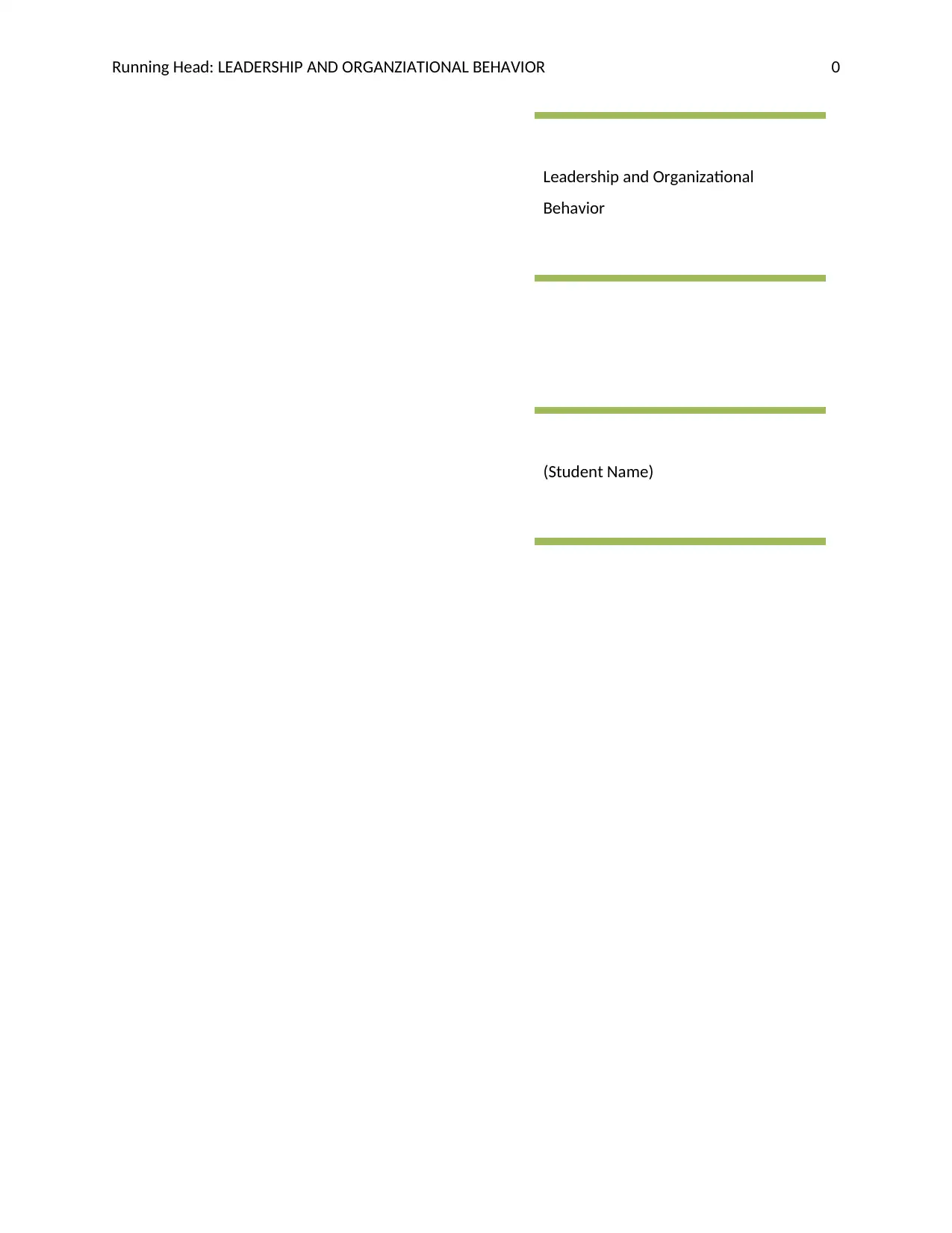
Running Head: LEADERSHIP AND ORGANZIATIONAL BEHAVIOR 0
Leadership and Organizational
Behavior
(Student Name)
Leadership and Organizational
Behavior
(Student Name)
Paraphrase This Document
Need a fresh take? Get an instant paraphrase of this document with our AI Paraphraser
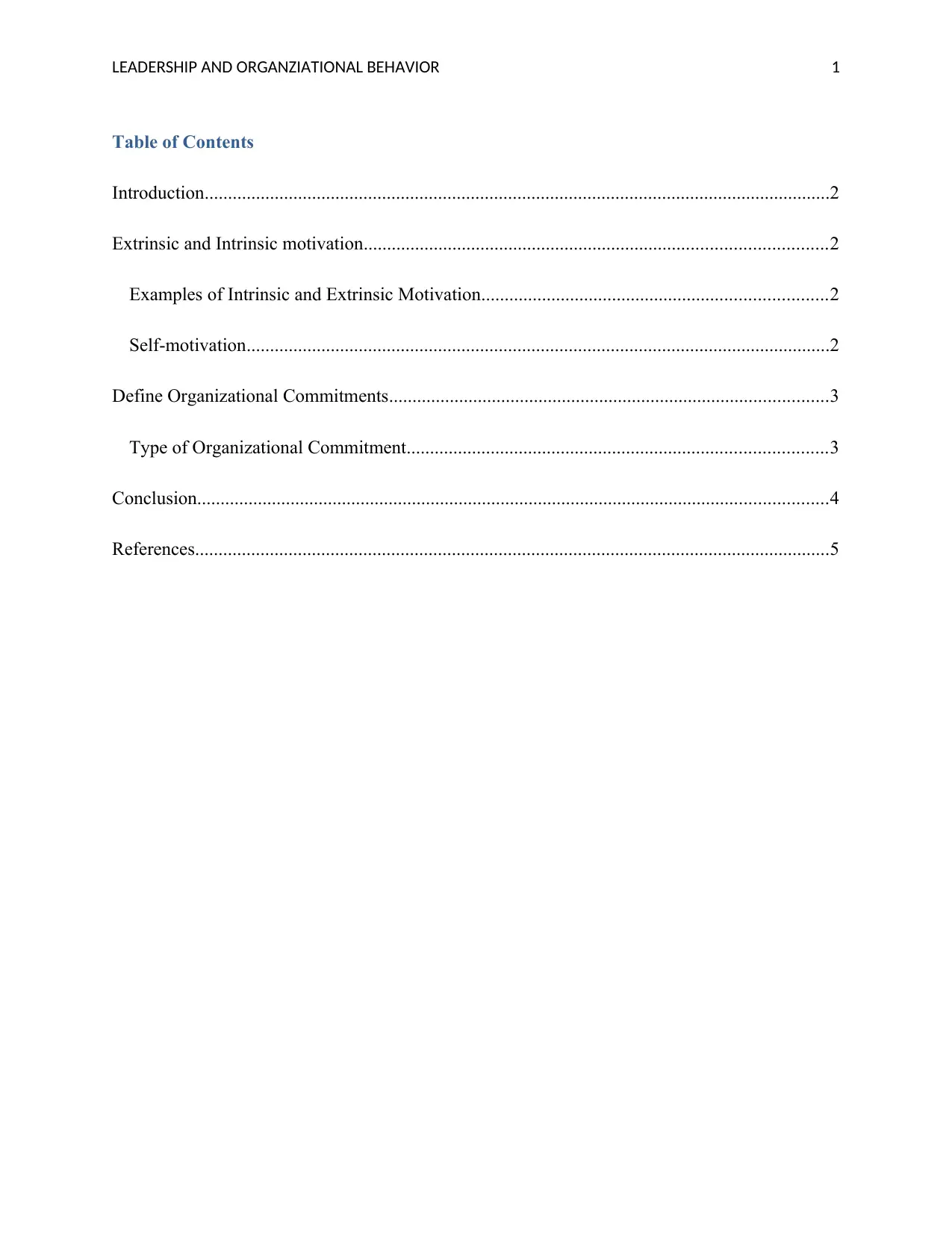
LEADERSHIP AND ORGANZIATIONAL BEHAVIOR 1
Table of Contents
Introduction......................................................................................................................................2
Extrinsic and Intrinsic motivation...................................................................................................2
Examples of Intrinsic and Extrinsic Motivation..........................................................................2
Self-motivation.............................................................................................................................2
Define Organizational Commitments..............................................................................................3
Type of Organizational Commitment..........................................................................................3
Conclusion.......................................................................................................................................4
References........................................................................................................................................5
Table of Contents
Introduction......................................................................................................................................2
Extrinsic and Intrinsic motivation...................................................................................................2
Examples of Intrinsic and Extrinsic Motivation..........................................................................2
Self-motivation.............................................................................................................................2
Define Organizational Commitments..............................................................................................3
Type of Organizational Commitment..........................................................................................3
Conclusion.......................................................................................................................................4
References........................................................................................................................................5
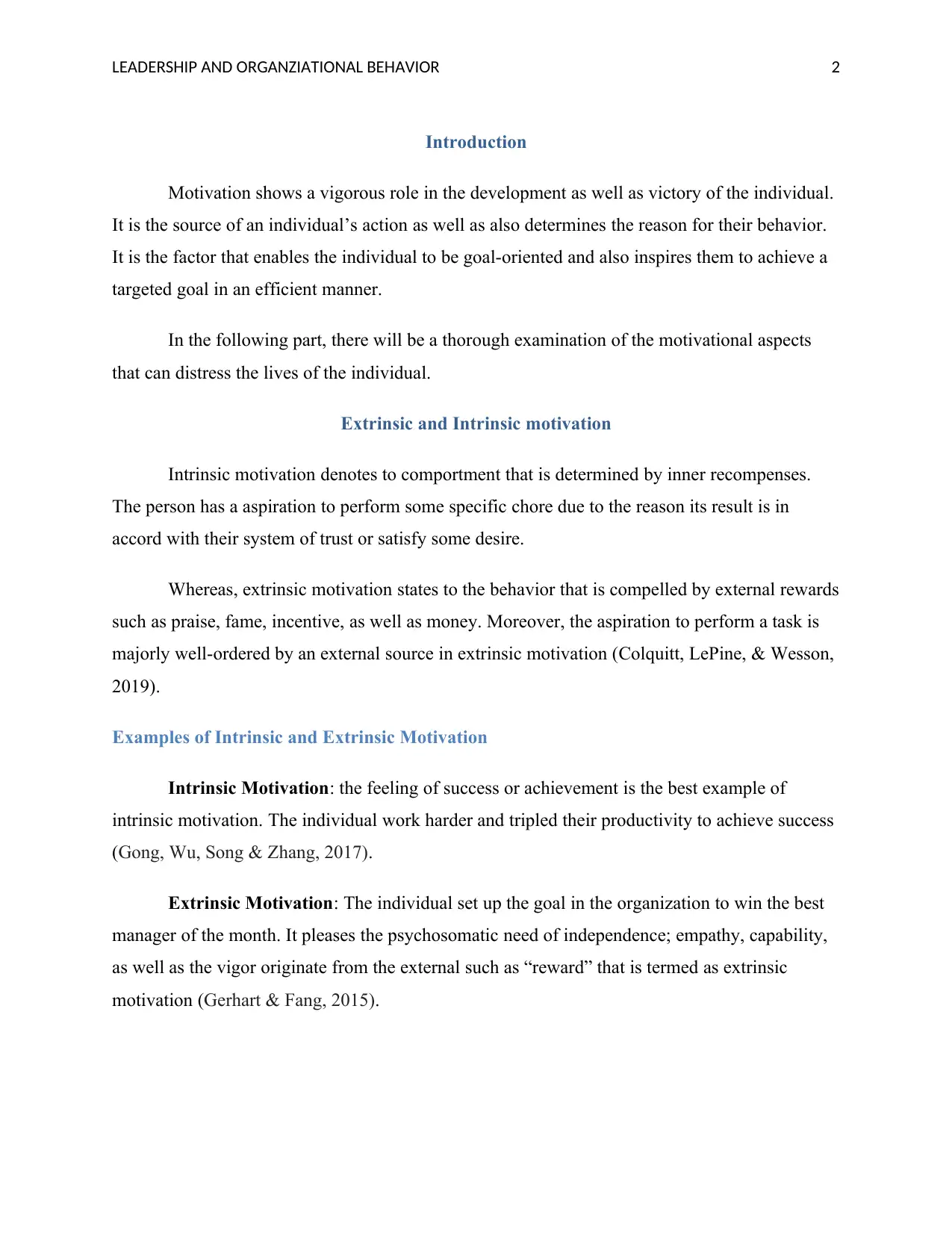
LEADERSHIP AND ORGANZIATIONAL BEHAVIOR 2
Introduction
Motivation shows a vigorous role in the development as well as victory of the individual.
It is the source of an individual’s action as well as also determines the reason for their behavior.
It is the factor that enables the individual to be goal-oriented and also inspires them to achieve a
targeted goal in an efficient manner.
In the following part, there will be a thorough examination of the motivational aspects
that can distress the lives of the individual.
Extrinsic and Intrinsic motivation
Intrinsic motivation denotes to comportment that is determined by inner recompenses.
The person has a aspiration to perform some specific chore due to the reason its result is in
accord with their system of trust or satisfy some desire.
Whereas, extrinsic motivation states to the behavior that is compelled by external rewards
such as praise, fame, incentive, as well as money. Moreover, the aspiration to perform a task is
majorly well-ordered by an external source in extrinsic motivation (Colquitt, LePine, & Wesson,
2019).
Examples of Intrinsic and Extrinsic Motivation
Intrinsic Motivation: the feeling of success or achievement is the best example of
intrinsic motivation. The individual work harder and tripled their productivity to achieve success
(Gong, Wu, Song & Zhang, 2017).
Extrinsic Motivation: The individual set up the goal in the organization to win the best
manager of the month. It pleases the psychosomatic need of independence; empathy, capability,
as well as the vigor originate from the external such as “reward” that is termed as extrinsic
motivation (Gerhart & Fang, 2015).
Introduction
Motivation shows a vigorous role in the development as well as victory of the individual.
It is the source of an individual’s action as well as also determines the reason for their behavior.
It is the factor that enables the individual to be goal-oriented and also inspires them to achieve a
targeted goal in an efficient manner.
In the following part, there will be a thorough examination of the motivational aspects
that can distress the lives of the individual.
Extrinsic and Intrinsic motivation
Intrinsic motivation denotes to comportment that is determined by inner recompenses.
The person has a aspiration to perform some specific chore due to the reason its result is in
accord with their system of trust or satisfy some desire.
Whereas, extrinsic motivation states to the behavior that is compelled by external rewards
such as praise, fame, incentive, as well as money. Moreover, the aspiration to perform a task is
majorly well-ordered by an external source in extrinsic motivation (Colquitt, LePine, & Wesson,
2019).
Examples of Intrinsic and Extrinsic Motivation
Intrinsic Motivation: the feeling of success or achievement is the best example of
intrinsic motivation. The individual work harder and tripled their productivity to achieve success
(Gong, Wu, Song & Zhang, 2017).
Extrinsic Motivation: The individual set up the goal in the organization to win the best
manager of the month. It pleases the psychosomatic need of independence; empathy, capability,
as well as the vigor originate from the external such as “reward” that is termed as extrinsic
motivation (Gerhart & Fang, 2015).
⊘ This is a preview!⊘
Do you want full access?
Subscribe today to unlock all pages.

Trusted by 1+ million students worldwide
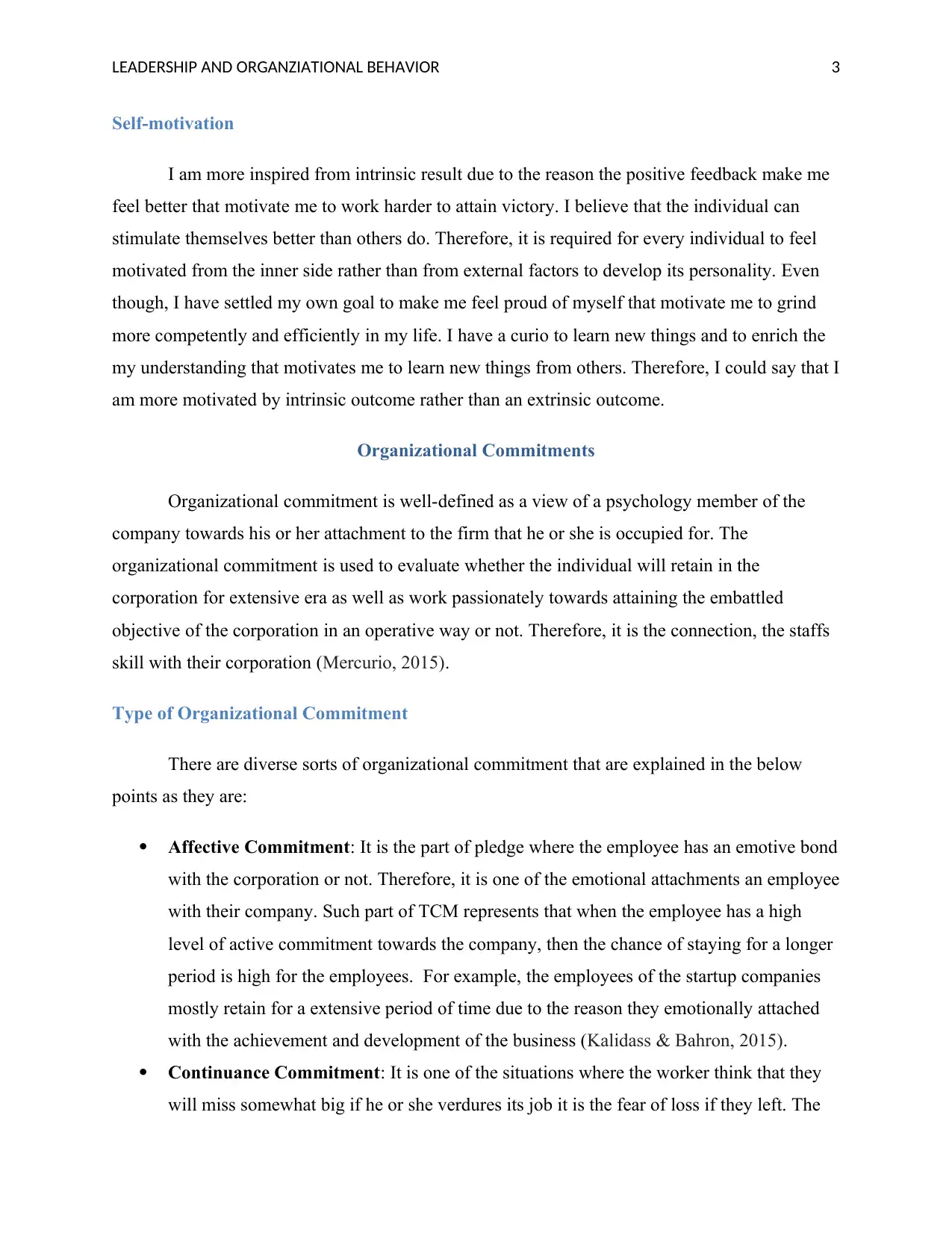
LEADERSHIP AND ORGANZIATIONAL BEHAVIOR 3
Self-motivation
I am more inspired from intrinsic result due to the reason the positive feedback make me
feel better that motivate me to work harder to attain victory. I believe that the individual can
stimulate themselves better than others do. Therefore, it is required for every individual to feel
motivated from the inner side rather than from external factors to develop its personality. Even
though, I have settled my own goal to make me feel proud of myself that motivate me to grind
more competently and efficiently in my life. I have a curio to learn new things and to enrich the
my understanding that motivates me to learn new things from others. Therefore, I could say that I
am more motivated by intrinsic outcome rather than an extrinsic outcome.
Organizational Commitments
Organizational commitment is well-defined as a view of a psychology member of the
company towards his or her attachment to the firm that he or she is occupied for. The
organizational commitment is used to evaluate whether the individual will retain in the
corporation for extensive era as well as work passionately towards attaining the embattled
objective of the corporation in an operative way or not. Therefore, it is the connection, the staffs
skill with their corporation (Mercurio, 2015).
Type of Organizational Commitment
There are diverse sorts of organizational commitment that are explained in the below
points as they are:
Affective Commitment: It is the part of pledge where the employee has an emotive bond
with the corporation or not. Therefore, it is one of the emotional attachments an employee
with their company. Such part of TCM represents that when the employee has a high
level of active commitment towards the company, then the chance of staying for a longer
period is high for the employees. For example, the employees of the startup companies
mostly retain for a extensive period of time due to the reason they emotionally attached
with the achievement and development of the business (Kalidass & Bahron, 2015).
Continuance Commitment: It is one of the situations where the worker think that they
will miss somewhat big if he or she verdures its job it is the fear of loss if they left. The
Self-motivation
I am more inspired from intrinsic result due to the reason the positive feedback make me
feel better that motivate me to work harder to attain victory. I believe that the individual can
stimulate themselves better than others do. Therefore, it is required for every individual to feel
motivated from the inner side rather than from external factors to develop its personality. Even
though, I have settled my own goal to make me feel proud of myself that motivate me to grind
more competently and efficiently in my life. I have a curio to learn new things and to enrich the
my understanding that motivates me to learn new things from others. Therefore, I could say that I
am more motivated by intrinsic outcome rather than an extrinsic outcome.
Organizational Commitments
Organizational commitment is well-defined as a view of a psychology member of the
company towards his or her attachment to the firm that he or she is occupied for. The
organizational commitment is used to evaluate whether the individual will retain in the
corporation for extensive era as well as work passionately towards attaining the embattled
objective of the corporation in an operative way or not. Therefore, it is the connection, the staffs
skill with their corporation (Mercurio, 2015).
Type of Organizational Commitment
There are diverse sorts of organizational commitment that are explained in the below
points as they are:
Affective Commitment: It is the part of pledge where the employee has an emotive bond
with the corporation or not. Therefore, it is one of the emotional attachments an employee
with their company. Such part of TCM represents that when the employee has a high
level of active commitment towards the company, then the chance of staying for a longer
period is high for the employees. For example, the employees of the startup companies
mostly retain for a extensive period of time due to the reason they emotionally attached
with the achievement and development of the business (Kalidass & Bahron, 2015).
Continuance Commitment: It is one of the situations where the worker think that they
will miss somewhat big if he or she verdures its job it is the fear of loss if they left. The
Paraphrase This Document
Need a fresh take? Get an instant paraphrase of this document with our AI Paraphraser
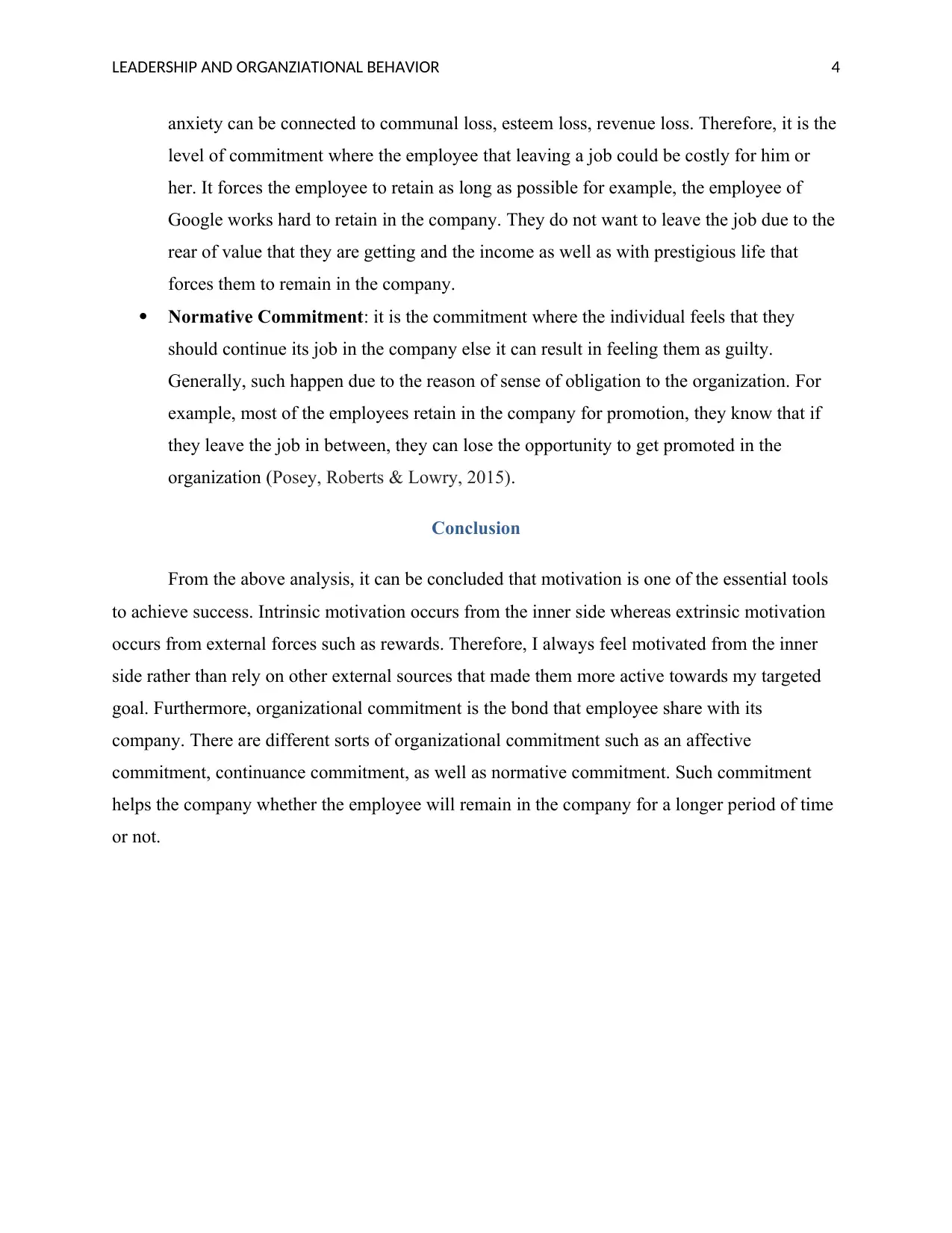
LEADERSHIP AND ORGANZIATIONAL BEHAVIOR 4
anxiety can be connected to communal loss, esteem loss, revenue loss. Therefore, it is the
level of commitment where the employee that leaving a job could be costly for him or
her. It forces the employee to retain as long as possible for example, the employee of
Google works hard to retain in the company. They do not want to leave the job due to the
rear of value that they are getting and the income as well as with prestigious life that
forces them to remain in the company.
Normative Commitment: it is the commitment where the individual feels that they
should continue its job in the company else it can result in feeling them as guilty.
Generally, such happen due to the reason of sense of obligation to the organization. For
example, most of the employees retain in the company for promotion, they know that if
they leave the job in between, they can lose the opportunity to get promoted in the
organization (Posey, Roberts & Lowry, 2015).
Conclusion
From the above analysis, it can be concluded that motivation is one of the essential tools
to achieve success. Intrinsic motivation occurs from the inner side whereas extrinsic motivation
occurs from external forces such as rewards. Therefore, I always feel motivated from the inner
side rather than rely on other external sources that made them more active towards my targeted
goal. Furthermore, organizational commitment is the bond that employee share with its
company. There are different sorts of organizational commitment such as an affective
commitment, continuance commitment, as well as normative commitment. Such commitment
helps the company whether the employee will remain in the company for a longer period of time
or not.
anxiety can be connected to communal loss, esteem loss, revenue loss. Therefore, it is the
level of commitment where the employee that leaving a job could be costly for him or
her. It forces the employee to retain as long as possible for example, the employee of
Google works hard to retain in the company. They do not want to leave the job due to the
rear of value that they are getting and the income as well as with prestigious life that
forces them to remain in the company.
Normative Commitment: it is the commitment where the individual feels that they
should continue its job in the company else it can result in feeling them as guilty.
Generally, such happen due to the reason of sense of obligation to the organization. For
example, most of the employees retain in the company for promotion, they know that if
they leave the job in between, they can lose the opportunity to get promoted in the
organization (Posey, Roberts & Lowry, 2015).
Conclusion
From the above analysis, it can be concluded that motivation is one of the essential tools
to achieve success. Intrinsic motivation occurs from the inner side whereas extrinsic motivation
occurs from external forces such as rewards. Therefore, I always feel motivated from the inner
side rather than rely on other external sources that made them more active towards my targeted
goal. Furthermore, organizational commitment is the bond that employee share with its
company. There are different sorts of organizational commitment such as an affective
commitment, continuance commitment, as well as normative commitment. Such commitment
helps the company whether the employee will remain in the company for a longer period of time
or not.

LEADERSHIP AND ORGANZIATIONAL BEHAVIOR 5
References
Colquitt, J. A., LePine, J. A., & Wesson, M. J. (2019). Organizational behaviour: Improving
performance and commitment in the workplace. (6th Ed.) New York :
McGraw-Hill/Irwin.
Gerhart, B., & Fang, M. (2015). Pay, intrinsic motivation, extrinsic motivation, performance, and
creativity in the workplace: Revisiting long-held beliefs. Annu. Rev. Organ. Psychol.
Organ. Behav., 2(1), 489-521.
Gong, Y., Wu, J., Song, L. J., & Zhang, Z. (2017). Dual tuning in creative processes: Joint
contributions of intrinsic and extrinsic motivational orientations. Journal of Applied
Psychology, 102(5), 829.
Kalidass, A., & Bahron, A. (2015). The relationship between perceived supervisor support,
perceived organizational support, organizational commitment and employee turnover
intention. International Journal of Business Administration, 6(5), 82.
Mercurio, Z. A. (2015). Affective commitment as a core essence of organizational commitment:
an integrative literature review. Human Resource Development Review, 14(4), 389-414.
Posey, C., Roberts, T. L., & Lowry, P. B. (2015). The impact of organizational commitment on
insiders’ motivation to protect organizational information assets. Journal of Management
Information Systems, 32(4), 179-214.
References
Colquitt, J. A., LePine, J. A., & Wesson, M. J. (2019). Organizational behaviour: Improving
performance and commitment in the workplace. (6th Ed.) New York :
McGraw-Hill/Irwin.
Gerhart, B., & Fang, M. (2015). Pay, intrinsic motivation, extrinsic motivation, performance, and
creativity in the workplace: Revisiting long-held beliefs. Annu. Rev. Organ. Psychol.
Organ. Behav., 2(1), 489-521.
Gong, Y., Wu, J., Song, L. J., & Zhang, Z. (2017). Dual tuning in creative processes: Joint
contributions of intrinsic and extrinsic motivational orientations. Journal of Applied
Psychology, 102(5), 829.
Kalidass, A., & Bahron, A. (2015). The relationship between perceived supervisor support,
perceived organizational support, organizational commitment and employee turnover
intention. International Journal of Business Administration, 6(5), 82.
Mercurio, Z. A. (2015). Affective commitment as a core essence of organizational commitment:
an integrative literature review. Human Resource Development Review, 14(4), 389-414.
Posey, C., Roberts, T. L., & Lowry, P. B. (2015). The impact of organizational commitment on
insiders’ motivation to protect organizational information assets. Journal of Management
Information Systems, 32(4), 179-214.
⊘ This is a preview!⊘
Do you want full access?
Subscribe today to unlock all pages.

Trusted by 1+ million students worldwide
1 out of 6
Related Documents
Your All-in-One AI-Powered Toolkit for Academic Success.
+13062052269
info@desklib.com
Available 24*7 on WhatsApp / Email
![[object Object]](/_next/static/media/star-bottom.7253800d.svg)
Unlock your academic potential
Copyright © 2020–2025 A2Z Services. All Rights Reserved. Developed and managed by ZUCOL.




